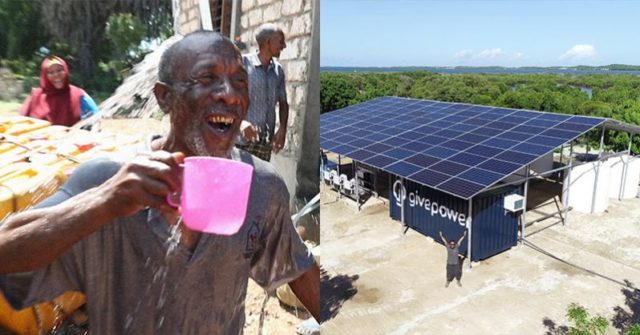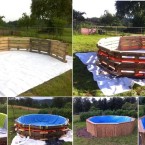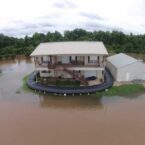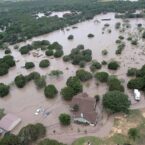Water should not be a luxury product, but still in these modern times, one out of nine people does not have access to clean drinking water. The main issue here is that only around 4% percent of Earth’s water sources are rivers, lakes and drinkable water, the rest is comprised of oceans with salty water.
These are all alarming statistics, but luckily in many such places around the world things are starting to improve thanks to new technologies.
One of the most active NGOs that are trying to fight for access to clean water is called Give Power and their main mission is to install solar power technology that can help the communities dealing with this issue.
Their most recent success story is related to Kenya and the village named Kiunga, where they managed to install a solar-powered desalination system. This system transforms ocean water into drinkable water and can produce enough water for 35 000 people per day (around 70 thousand liters). Before Give Power, the inhabitants of Kiunga had to travel one hour each day to reach a water source, but it was one used also by animals and full of parasites. Such improvements, like Give Power’s initiative, are constantly needed as according to the World Health Organization, there are still 2.2 billion people around the world who do not have access to drinking water and 4.2 billion can’t access safely managed sanitation services.
These things can lead to more issues like the spreading of diseases and dehydration in very hot and rural areas. So how does the process of desalination work exactly? It is a process in which salt and minerals are separated from the water through a membrane. But because liquid goes through an osmotic process in which its natural state is to have equal amounts of water, minerals, and salt on each side of the membrane, a lot of energy is required to stabilize it.
Also, post-processing requires a lot of chemicals to be added to the water for the desalination to happen. But Give Power, managed to find a solution to all this through their solar water farms, using solar panels, Tesla batteries, and water pumps. The other plus side of this technology is that the final product does not produce saline residues which pollute the environment.
Watch the video presentation made by Give Power, to learn more about this inspiring story.
















Very good
Amen!!!
This is one of the most important step one can take! It shows true ingenuity!
The facts you mentions dont add up. If the WHO say 2.2 billlion people don’t have access to clean drinking water, how can 1 out of 9 people not have access to clean water??
I guess if you’ve never lived in a 3rd world area your privilege would find that hard to comprehend. There are far more have nots on the planet than have it alls.
70 000 liter for 35 people, at least get your numbers right if you want us to believe the story
35 000 people .. was a mistake
READ… 35,000 not 35…are you vaccinated??
What happens to the salt that is a byproduct of desalination ?
They talk about adding chemicals as part of the process so it will be contaminated.
If the system is like the ones I’ve been around, there is a back flush cycle that rinses the membrane/media clean of salts, those salts are diluted and then flushed to the sea.
A wonderful thing!
But the reporter should check the article before sending it. He wrote that this support water for 35 people every day. In the film they say 35000 people.
You are right! was a mistake
GivePower desalination efforts are to be applauded but I’m so confused as to why they would align themselves with Bank of America who’s one of the top financiers of the fossil fuel industry. This now becomes a propaganda piece for BofA’s green washing….
You should know better GivePower.
It probably came down to the calculation of giving BOA a very small PR bump versus giving 10’s of thousands of people fresh water. Armchair idealism versus boots on the ground positive impacts.
No one else was lining up to pay for this. Good for the people.
Brilliant initiative,fantastic results!!
Just wondered ……
Wow , I hope this turns out to be cost effective and doesn’t pollute anything . A lot of countries and people would benefit . Thanks .
Excellent home design for the society
It’s so awesome that solar makes such a serious problem have a cost effective Solution like this. Would love to potentially help contribute with each solar sale my company does this year!
I’m really impressed to this kind of initiatives, providing clean drinkable Water to poor rural communities. If Gambia can have such initiatives would be fantastic. In this modern generation there are still communities in the Gambia that are seriously in need of clean and portable drinking water.
Also using solar power initiatives to pump out water would highly improves agricultural productivity around the year, rather than just depending on rain water for farming.
ItS would really interesting to have a kind of partnership with your solar power initiatives for Gambia.
Cheers,
Ibou Camara
Managing Director Real Tech Gambia Ltd
just to let you know, there is a mistake in your post. It says 35 peoples per day I think that you wanted to say 35000. Also what you are doing is amazing
There seems to be a typo in the written article. The desalination system claims to supply water to 35 people per day. In the video it claims 35,000 people. I’m not sure 2 liters of water per day is enough for 35000 people to survive on, but maybe check your #s and daily requirements. Maybe somewhere in between 35 and 35000 people. ???? That is a huge range.
Thanks for clarifying.
Please help Malinao Albay Philippines. We need clean, potable water as well and we have costal areas that can be the source of micro grid desalination system. Its been decades that our beloved municipality endured shortage of safe water. If you come to visit us, you will know the reason why and also why give power is i think the best solution to all our problems.
How much do you think would be the overall cost of this project if is going to be installed in Taounate, in the Rif region, north of Morocco?
Veru good work.
Una Maravilla.. Nos gustaría conocer más. Gracias
This is bull, you remove salt from salt water, you have salt left over, thats a simple fact. no machine magically makes the salt go away like magic.
You might want to educate yourself further on reverse osmosis…
Magic does not exist, however Science does. There are several ways to desalinate water; steam distillation, this uses heat to transform salt water into steam which is then cooled and coalesced into super pure fresh water with no mineral content; reverse osmosis, this uses a semipermeable membrane with pores so small only pure water can pass from the salty water side to the fresh water side and the saltier water is discharged to open ocean.
It’s good use of science and technology. Go back to school Brian! It doesn’t say the salt is eliminated but removed from the water to improve health and well-being. Duh!
This is best thing I’ve seen today which can help our widows in Kenya.
Hopefully this will succeed and spread around the world.
In your video you mentionned that one of your next target country is Haiti… That’s brilliant!! I’m a Native Haitian who knows his country’s limitations extremely well… How can I be of assistance to this project of bringing fresh and unsalted water ? to my country?
Article says 35 people per day. It should say 35000.
The article states it produces enough water for 35 people per day but that number should be 35,000 according to the video 🙂
correct the text of the article…70 000 l per day is enough for 35000 people per day not only 35 as its written. In video they say 35000
Uzbekistan (Karakalpakstan) does also need your help
It’s 35000 people per day not 35 as the article states.
How do 35 people consume 70,000 litres of water in one day?
Good job
Please share the details of the project. We require a similar project in India. I will be interested to know more details about the project. I plan on doing a similar project in India
Thanks to all scientists and technicians and workers that made this solar desalination plant possible
Thank you, “Give Power” Thank you for caring!
Would creating greenhouse with a shallow pool pumped full so seawater and heated by the sun threw the glass pains and add magnifying lens if necessary to heat the pools and then pipelines with cool water running threw them to create condensation on them which could run to collection troughs and tanks for the condensate water which should be desalinated by the natural evaporation process and ready for testing for drinking. Also the sides around the pools within the greenhouse could be used to grow food as well and salt water plants could be added in the pools to help with water temperatures and aeration added as well. Just a thought and vision I have had which could help with water shortage in the world.
Note how happy those Kenyans are after tasting clear, cold water! Now imagine that happiness being spread around earth as more and more people are provided with their basic human daily needs! I am so happy to know that after the evil ones are all killed, that earthlings will indeed become happy. Death to the slavemasters and deep state and all their ilk. Let love flourish and happiness is the by-product. Thank you Shweta for posting this video.
We would like to be in touch with these specialists. We are a nonprofit organization located in the USA
35 people drink 70,000 liters a day? Get your numbers right. If these people would build pipelines, they would have access to clean water. Did some other country give America clean drinking water? Or did we just build
It all
Ourselves decades ago
Something does not sound right. 70,000 liters for 35 people. Somebody else must have flagged this.
I completely understand what it is like to grow up without clean running water or electricity. I grow up in South Africa under the apartheid regime of Indian parentage. We lived by by collecting rain water in a large tank attached to the tin roof of our house for cooking, bathing and washing clothes. Today I am one of “Top Advanced Robotic Colon Cancer Surgeon”, educated in London n Dublin. Indians were not allowed to attend medical school in South Africa. I am 87 year old n training surgeons all over the world in Robotics. What u guys are doing is outstanding
“water for 35 people per day (around 70 thousand liter)”???
Unless these people are all filling swimming pools then one of these numbers is wrong. This is a great development but I really would be interested in correct numbers.
Thanks for the great work.
Excellent! Could I more information about this project?
Thanks.
Very nice piece of work done! I feel like contributing in the same area for Philippines. Could I get info like how much investment for the water farm like this, specifications for solar panels and batteries, the process information so that I could do the same in Philippines, even in isolated islands in Japan. Thank you!
It says 70 thousand litres a day of water for just 35 people. Is that right. I cannot image that each person uses that much water!!
What an excellent initiative.
No saline residue is key. In saudi they desalinated water and dumped the salt back in the ocean. Created too much salt and it caused the process to fsil.
I’ve been wondering about the practicality of this for years. It’s wonderful to see something like it in operation. Although to me it seems like an over complex system. Surely using the sun directly to drive an evaporative system with sea-cooled condensers would be more efficient and easier to develop. to They don’t go into detail about the process, just some vague talk of osmosis, and they talk of adding chemical during an osmotic process… so the resultant salt will be heavily contaminated. Using simple evaporation would produce saleable sea-salt. Many people are prepared to pay high sums of money for this product so they could finance the building of more plants.
wondering how the (salt) water is delivered to the site?
Fantastic initiative. Well done, Give Power
Please let me read article or report. Very interested. Agronomist.
based on my analization for their article, it was estimated that 2 liters of water per person.
How much did this renewal energy system, cost the government of Kenya?
Thank God. Nothing is impossible ♥️. Good engineers. Thanks for sharing your knowledge on your field.
Thank you for the love to the people…such initiative changes lives of many.Good job👏👏
It say’s 35.000 people, not 35
says 35.000 people, not 35
Great, there are countries that until they figure out how to charge people or tax it they will not supply it to the people. Like here in America
It says 35,000 people. I copied n pasted wording direct from article: (This system transforms ocean water into drinkable water and can produce enough water for 35 000 people per day (around 70 thousand liters)
Would be better if they didn’t charge the poor to drink it
They said they can produce 70000 litres per day, good for 35000 people…2 litres per day per person…
It’s 35,000 people that get 2 litres a day! Wonderful